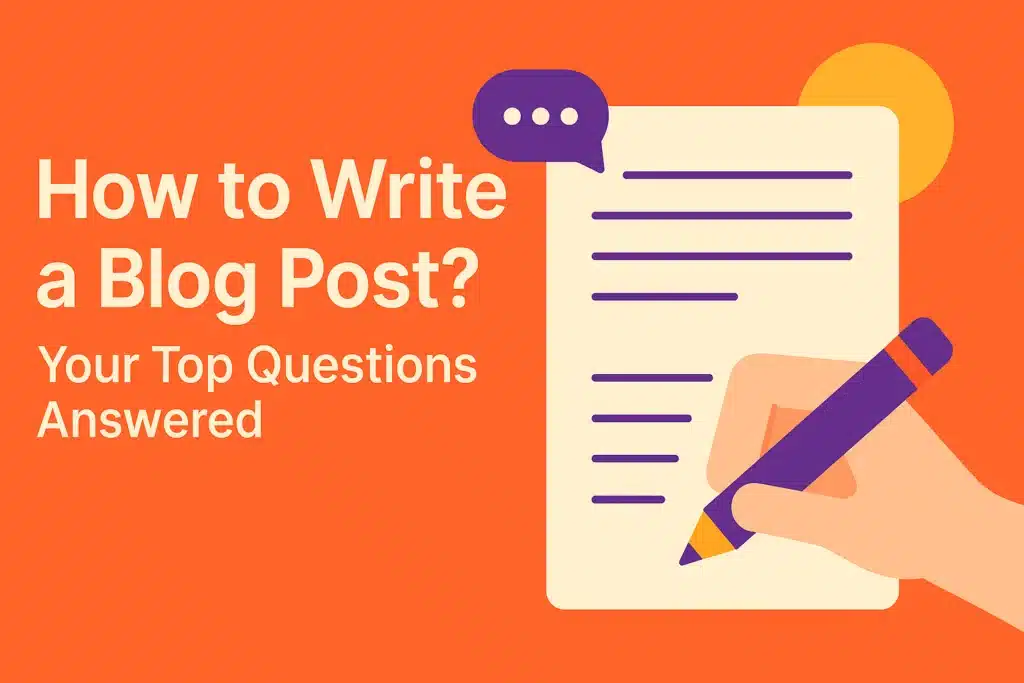Placing personal reflections on the web can start exchange and create fresh chances. Many people wonder how to write a blog post that stands out. Whether there’s a plan to share favorite hobbies, expert insights, or personal stories, a blog can help build a global connection. This guide explains each step, from starting a blog to editing final drafts.
Blogging fits multiple aims. Some do it for business when building trust with potential clients. Others do it to share personal passions. The process looks complex, but it follows simple steps. This resource answers questions and offers useful tips for success.
What is a Blog Post and Why Write One?
A blog post is a focused piece of online content on a website. People write it to share updates, educate audiences, or share viewpoints. Businesses use posts to reach new markets and build trust. Some bloggers focus on personal stories, while others create how-to guides or tutorials. Whenever people wonder how to write a blog post, they often ask: what value does it bring? Blog posts can promote interaction on different platforms.
Understanding the purpose of blog posts
Blog posts give groups and people a way to reach audiences, attract leads, and show industry expertise. They draw visitors through search engines and social platforms, increasing visibility. 76% of B2B marketers see blogs as helpful for lead generation (HubSpot Blog). These pieces remain online and bring consistent traffic. They build trust, provide information, and inform readers over the long-term.
Common types of blog content
Bloggers change their content by creating list-based articles, how-to pieces, visual charts, checklists, guest posts, or profiles. Lists often get higher shares (SmartBug Media). How-to posts educate audiences. Visual charts increase brand awareness but may not get as many leads (SmartBug Media). Guest posts invite new perspectives, and profiles feature experts. Mixing formats prevents boredom and keeps readers engaged. These choices create variety.
How blogs help build authority and trust
Sharing unique insights online establishes a blogger as a thought leader who influences discussions and solves relevant issues. Genuine stories show an honest side. Readers value voices that mix expertise with a personal style (Penn LPS Online). Consistent posts build trust over time and encourage loyal followings. Fresh viewpoints distinguish bloggers from those repeating topics. Readers trust someone who guides discussions.
How to Start a Blog: The First Steps
Many beginners ask how to start a blog without feeling bored or stressed. The approach includes choosing a niche, setting simple aims, and finding a reliable platform. It also involves picking hosting and a domain, then customizing a design. Once launched, consistency is important. Posting often creates progress. Sharing those posts across social platforms increases visibility. These initial steps lay the foundation for strong growth, engagement, and future influence in blogging.
Pick your blog niche and goals
A niche defines the main topic your blog covers, such as travel, marketing, or cooking. Narrowing your focus helps you stand out and attract the right audience. Choose goals like building a personal brand, earning money, or sharing expertise. Clear objectives guide piece of content. Write about topics you understand and enjoy to stay motivated. This direction guides your blog toward success.
Set up your blogging platform
WordPress is still popular, used by more than 82 million users (Quora). Free platforms exist, yet paid hosting and a custom domain create a more polished look. To install right away, pick a trusted hosting provider, then link your domain. Next, start writing from WordPress or check out other options like Blogger or Medium. Customize the theme, add key plugins, and just begin posting.
Create a content plan for consistency
A content plan lists your topics, posting frequency, and objectives. Setting SMART goals keeps you organized (Surfer SEO). Decide how often to publish, then list relevant ideas matching your niche. Use tools like Google Keyword Planner or focused research platforms to find good topics. Focus on audience needs. An organized plan boosts routine and quality, helping the blog grow over time.
How to Write a Blog Post Step-by-Step
Writing a strong post involves identifying your audience, organizing essential ideas, and writing interesting openings and endings. Match your details with reader concerns, then research and plan sections before drafting. Keep paragraphs short and language concise. Once a rough draft is written, edit for clarity and add important keywords. This step-by-step method simplifies how to write a blog post. Then improve format, settle on style, and proofread for grammar. Steady practice improves skills.
Choose a clear topic and target audience
Identify who your readers are and which themes matter most to them. Research keywords with good search volume and lower competition (Medium). Selecting a specific topic helps create clear content that addresses real problems. Stick to two or three main subjects throughout your blog. This method helps content stay unified and attracts people looking for direct answers. Know your audience well.
Research and outline your key points
Start with competitor review, looking at popular posts and finding gaps you can fill. Create an outline to plan sections and subtopics before writing. This outline makes drafting easier and helps ideas flow. Gather data or personal stories to support your points. Highlight each section with headings to guide readers. A clear structure keeps your thoughts on track and reduces confusion.
Write an engaging introduction and strong conclusion
Your opening lines should attract readers, explain the background, and show why they need the entire post. Use an interesting statement or a brief anecdote. Conclude by repeating the central message and offering clear ending. Carefully finish with a simple prompt or question that makes readers think. This structure helps guide their overall experience and makes sense to the result.
Blog Writing Tips Backed by Best Practices
Practical methods help bloggers write posts that readers value. Plain language, organized layout, and thorough editing are key to effective blogging. These best practices focus on formatting, SEO, and user experience. Short paragraphs and clear headings keep overall attention and help better understanding. Grammar checks maintain clarity. Subheadings show major ideas. Such methods reduce reader drop-off. High-value details rank higher in search rankings. Steady routine helps each entry succeed.
Use simple language and short paragraphs
Readers stay interested when text is easy to follow. Short paragraphs let them read very quickly, mainly online. Each paragraph covers just one main idea. Avoid too much jargon or long words. Shorten sentences that are too long. A clear style helps with focus. This approach suits those wanting to learn how to write a blog post without creating confusion. Brevity provides clarity.
Structure your content using headings and lists
Separate large blocks of text into smaller sections. Headings and lists give quick strong guides. Roughly 36% of articles featuring H2 and H3 headings get better results (Kontent.ai). Bullet points or numbered lists show important details. Subheadings help search engines understand topic organization. Visitors decide quickly whether to stay. Very good formatting improves understanding. Each section has a clear purpose.
Edit for clarity, grammar, and SEO basics
After drafting, improve wording and remove extra unnecessary words. Keep paragraphs under seven lines (The Side Blogger). Check spelling and grammar with tools or careful reading. Insert your primary keyword naturally in headers, body, and metadata. Yoast SEO helps with titles and descriptions (The Side Blogger). Choose appropriate images with alt text for accessibility. Ensure every post reads smoothly and looks cohesive.
Many people hesitate when they wonder how to write a blog post. By defining a niche, choosing a good platform, and creating consistent material, the process becomes easier. Match your topics with audience interests and share genuine insights. Subjects that solve urgent problems connect more than random thoughts. Write introductions that get attention, add simple points, and produce a satisfying finish. Thoughtful editing also shapes the final draft. This complete approach builds trust, creates interest, and starts discussion. Blogging becomes more rewarding when you focus on creating valuable content often over time.
FAQs
What is the easiest way to learn how to write a blog post?
How often should I write blog posts as I start my blog?
What are key blog writing tips that help content rank?
Can I start a blog without any previous writing experience?
What are the best practices for blog writing in 2025?
How to start a blog that brings real traffic?

Ridam Khare is an SEO strategist with 7+ years of experience specializing in AI-driven content creation. He helps businesses scale high-quality blogs that rank, engage, and convert.



